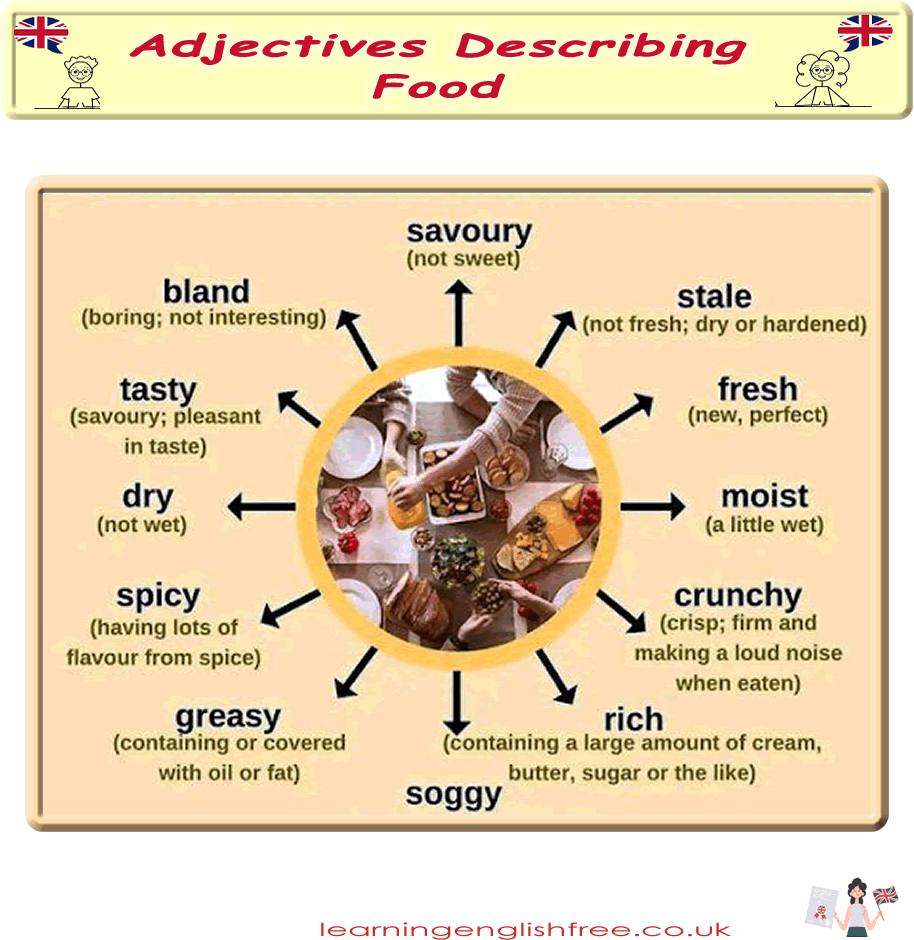
Introduction to Food Adjectives
Welcome to our delicious lesson on adjectives that describe food! Whether you're dining out, cooking at home, or simply chatting about food, the right adjectives can make your conversations more vivid and expressive. This lesson will introduce you to a variety of terms used to describe the taste, texture, and general appeal of food. By the end, you'll be able to share your culinary experiences more precisely and enjoyably. Let's enhance your English vocabulary with some flavourful words!
Understanding Food Adjectives
Savoury
- Meaning: Not sweet; often used to describe foods that are flavoured with salt or herbs.
- Example: "The savoury pie was filled with mushrooms and cheese, offering a delicious alternative to sweeter options."
Bland
- Meaning: Lacking strong flavour; not interesting.
- Example: "The soup tasted bland before we added some spices and herbs to enhance its flavour."
Stale
- Meaning: Not fresh; dry or hardened because of being left out in the air.
- Example: "The bread from yesterday has gone stale, making it tough and less enjoyable to eat."
Tasty
- Meaning: Flavourful and pleasant to taste.
- Example: "The homemade lasagna was incredibly tasty, with each layer offering a burst of flavour."
Fresh
- Meaning: Recently made or harvested; not stale or spoiled.
- Example: "The fresh strawberries from the market were juicy and sweet, perfect for a summer dessert."
Dry
- Meaning: Not wet; lacking moisture.
- Example: "The cake was unfortunately dry, suggesting it was overbaked."
Moist
- Meaning: Slightly wet; often used to describe desirable textures in baked goods.
- Example: "The chocolate cake was perfectly moist, with a rich, dense texture."
Spicy
- Meaning: Containing strong flavours from spices; can also indicate a level of heat.
- Example: "The curry was deliciously spicy, warming up the palate with its complex blend of spices."
Crunchy
- Meaning: Firm and making a loud noise when eaten; not soft.
- Example: "The fresh salad was full of crunchy vegetables, providing a satisfying texture."
Greasy
- Meaning: Containing or covered with a lot of oil or fat.
- Example: "The fries were too greasy, leaving an oily residue on the fingers."
Rich
- Meaning: Containing a large amount of fat, cream, butter, sugar, etc.; very filling and heavy.
- Example: "The dessert was rich and decadent, made with dark chocolate and fresh cream."
Soggy
- Meaning: Wet and soft, usually in an unpleasant way.
- Example: "The cereal became soggy after sitting too long in milk, losing its initial crunch."
Conclusion and Takeaways
Throughout this lesson, we've explored a variety of adjectives to describe food, enhancing your ability to communicate about culinary experiences in English. From the difference between "savoury" and "bland" to the textures described by "crunchy" and "soggy," these terms add richness to our descriptions and help us share our tastes and preferences more accurately.
Remember, practising these words in real-life situations will help solidify your understanding. Try using them in your daily conversations, whether you're discussing a meal you had, planning to cook, or simply talking about your favourite foods.
For remembering these adjectives, consider drawing pictures of foods and labelling them with the appropriate adjectives, creating mind-maps to connect similar terms, or leaving sticky notes around your kitchen as reminders.
Sharing your learning journey can also be incredibly rewarding. Visit our Facebook page at www.facebook.com/learningenglishfree.co.uk for more lessons and tips. Join our community to connect with fellow learners, share your progress, and discover new resources.
By incorporating these adjectives into your vocabulary, you'll find yourself engaging more confidently and vividly in conversations about food, further enriching your English language journey.
